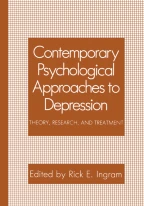
Abstract
The story that follows comes in three parts. First I will argue that there is, literally, an epidemic of depression today. Something has happened, roughly since world War II in America, so that depression is about ten times as common as it used to be. There are four independent lines of evidence suggesting that this is so. I will detail two well-done, large scale studies showing that the lifetime prevalence of depression in young people now exceeds by roughly a factor of ten the prevalence in young people 50 years ago. I will then look at two contemporary peoples who do not live in modern culture — the Kaluli of New Guinea and the Old Order Amish of Lancaster County, Pennsylvania. Neither of these pre-modern cultures has depression at anything like the prevalence we do.
This is a preview of subscription content, log in via an institution to check access.
Access this chapter
- Available as PDF
- Read on any device
- Instant download
- Own it forever
- eBook
- Price excludes VAT (USA)
- Available as EPUB and PDF
- Read on any device
- Instant download
- Own it forever
- Softcover Book
- Price excludes VAT (USA)
- Compact, lightweight edition
- Dispatched in 3 to 5 business days
- Free shipping worldwide - see info
Tax calculationcheckout
Purchases are for personal use only
Preview
Unable to display preview. Download preview PDF.
Similar content being viewed by others



References
-
Abramson, L.Y., Alloy, L.B., & Metalsky, G.I. (1988). The cognitive diathesis stress theories of depression: Toward an adequate evaluation of the theories’ validities. In L. B. Alloy (Ed.), Cognitive processes in depression. New York: Guilford Press.
Google Scholar
-
Abramson, L.Y., Seligman, M.E.P., & Teasdale, J. (1978). Learned helplessness in humans: Critique and reformulation. Journal of Abnormal Psychology, 87, 49–59
Article PubMed Google Scholar
-
Egeland, J.A. & Hostetter, A.M. (1983). Amish Study I: Affective disorders among the Amish, 1976–1980. American Journal of Psychiatry, 140, 56–61.
PubMed Google Scholar
-
Egeland„J.A., Hostetter, A.M., & Eshleman, S.K. (1983). Amish Study III: The impact of cultural factors on diagnosis of bipolar illness. American Journal of Psychiatry, 140, 67–71.
PubMed Google Scholar
-
Kleinman, A. (1982). Neurasthenia and depression: A study of somatization and culture in China. Cultural and Medical Psychiatry, 6, 117–190.
Article Google Scholar
-
Klerman, G. (1979). The age of melancholy. Psychology Today, 10, 37–88.
Google Scholar
-
Klerman, G. (1988). The current age of youthful melancholia. British Journal of Psychiatry, 152, 4–14.
Article PubMed Google Scholar
-
Klerman, G., Lavori, P., Rice, J., et al. (1985). Birth cohort trends in rates of major depressive disorder among relatives of patients with affective disorder. Archives of General Psychiatry, 42, 689–693.
PubMed Google Scholar
-
Murphy,.I., Sobol, A., Neff, R., Oliver, D., & Leighton, A. (1984). Stability of prevalence: Depression and anxiety disorders. Archives of General Psychiatry, 42, 689–693.
Google Scholar
Myers, J., Weissman, M., Tischler, G., et al. (1984), Six-month prevalence of psychiatric disorders in three communities. Archives of General Psychiatry, 41, 959–967.
-
Nozick, R. (1981). Philosophical explanations. Cambridge: Belknap Harvard.
Google Scholar
-
Reich, T., Van Eerdewegh, P., Rice, J., et al. (1988). The family transmission of primary major depressive disorder. Journal of Psychiatric Research, 41, 35–49.
Google Scholar
Robins, L., Heizer, J., Weissman, M., et al. (1984). Lifetime prevalence of specific psychiatric disorders in three sites. Archives of General Psychiatry, 41, 949–958.
-
Scheiffelin, E. (1984). The cultural analysis of depressive affect: An example from New Guinea. Unpublished manuscript, University of Pennsylvania.
Google Scholar
-
Seligman, M.E.P. (1975). Helplessness: On depression, development, and death. San Francisco: Freeman, 1975.
Google Scholar
Download references
Author information
Authors and Affiliations
-
Department of Psychology, University of Pennsylvania, Philadelphia, PA, 19174, USA
Martin E. P. Seligman
Editor information
Editors and Affiliations
-
Department of Psychology, San Diego State University, San Diego, California, USA
Rick E. Ingram
Rights and permissions
Reprintspermissions
Copyright information
© 1990 Plenum Press, New York
About this chapter
Cite this chapter
Seligman, M.E.P. (1990). Why Is There So Much Depression Today? The Waxing of the Individual and the Waning of the Commons. In: Ingram, R.E. (eds) Contemporary Psychological Approaches to Depression. Springer, Boston, MA. https://doi.org/10.1007/978-1-4613-0649-8_1
Download citation
DOIhttps://doi.org/10.1007/978-1-4613-0649-8_1
Publisher NameSpringer, Boston, MA
Print ISBN978-1-4612-7909-9
Online ISBN978-1-4613-0649-8
eBook PackagesSpringer Book Archive
Publish with us
Policiesethics

































